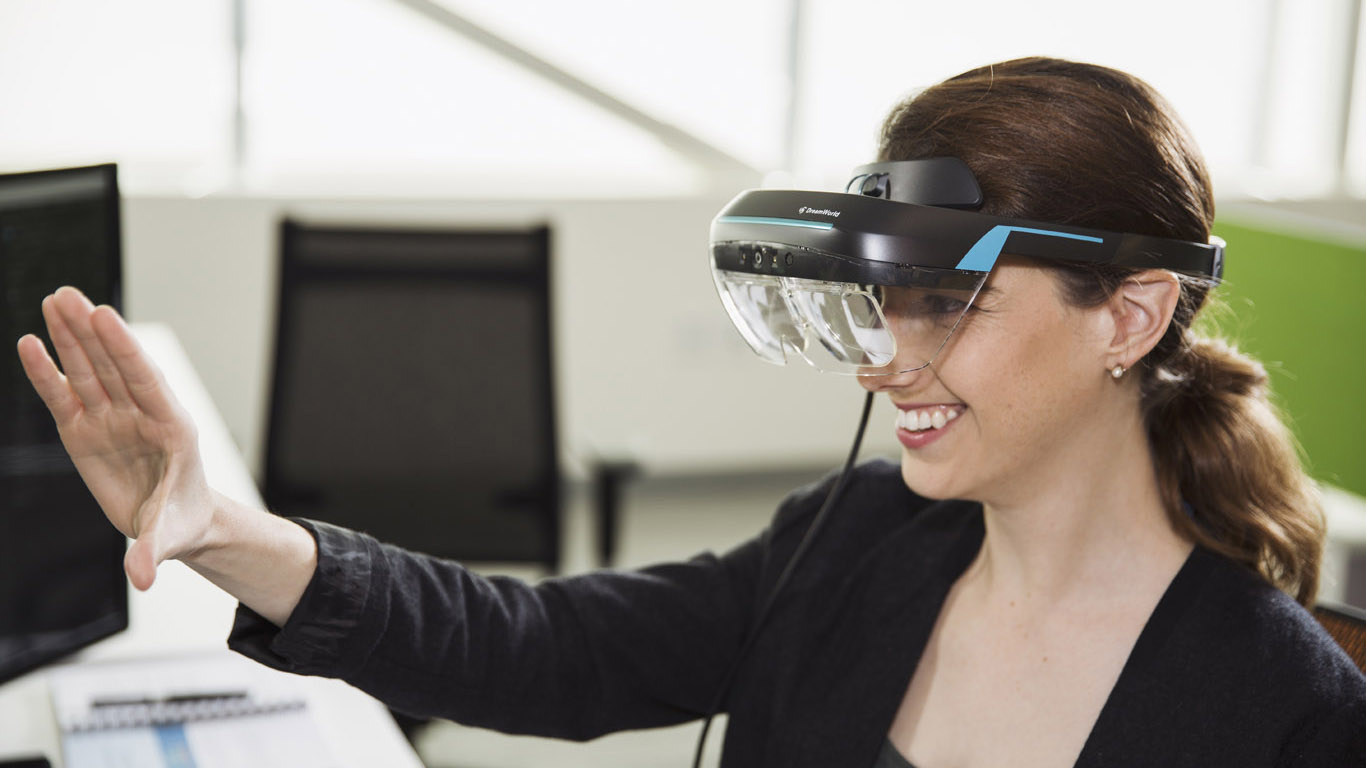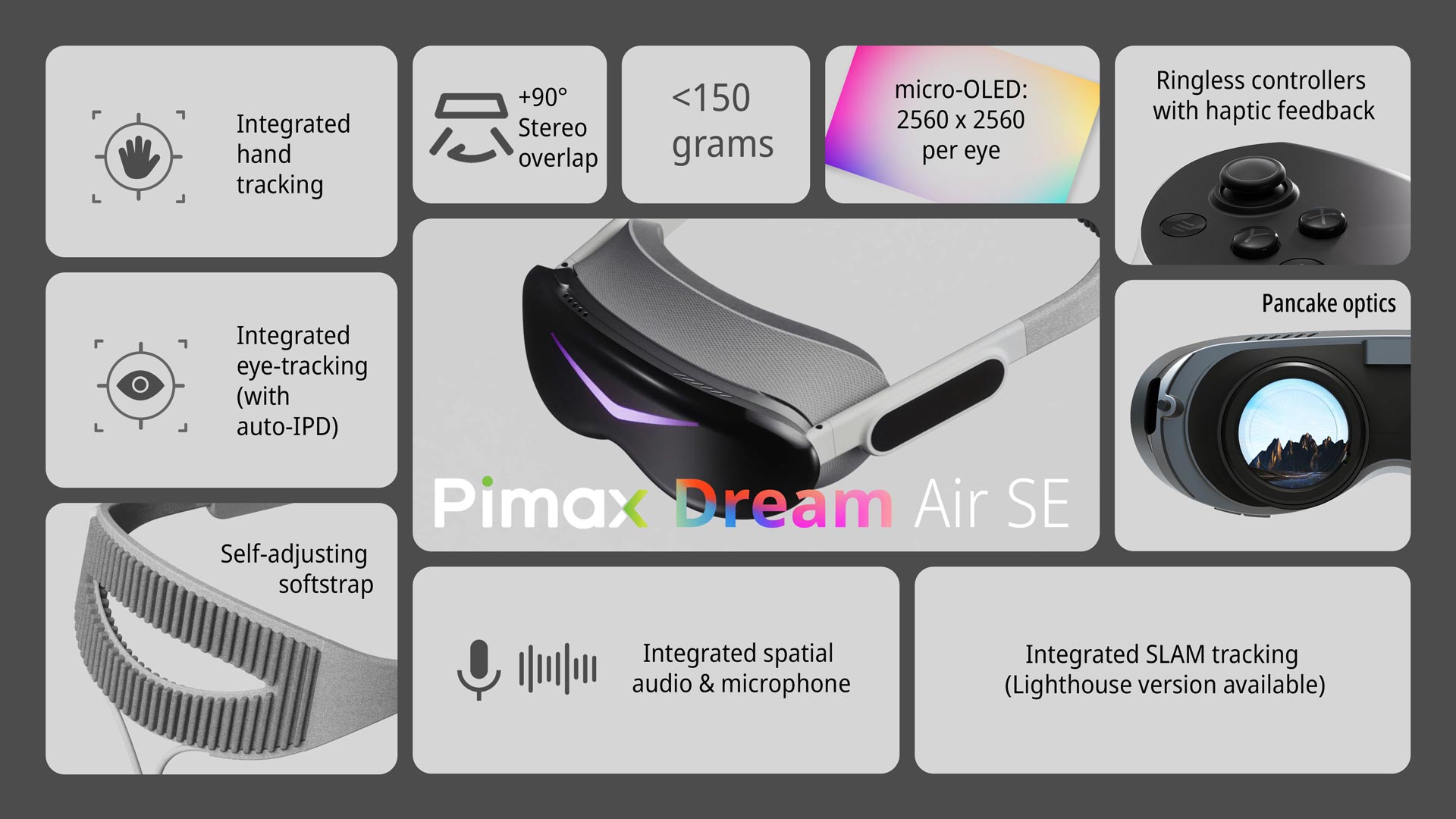DreamGlass is an interesting Augmented Reality glass that costs only $399
Some days ago, I’ve got to know through Reddit a new Augmented Reality headset called DreamGlass. I got intrigued by it and especially by its rather low price of $399, so I start investigating its characteristics. In this article I want to show you what it is, its characteristics and also a brief interview with DreamGlass CEO, so that you can decide if it is something that suits your needs.
DreamGlass is a product of a company called Dreamworld: it is a cheap augmented reality headset made for developers. It is not super-cheap as the Aryzon viewer (that costs $30): costing $399, it is still a gadget tailored at enthusiasts, but it is far cheaper than a professional device like the HoloLens. The advantage over Aryzon is that Dreamworld is more solid (it is made of plastic) and has far more features, while the advantage is that it costs a lot more. With regard to HoloLens, instead, this device is far cheaper, but it lacks the Windows 10 ecosystem and especially the environmental tracking features and the standalone form factor. We all know that in AR and VR we don’t have the perfect device yet, so we have always to make compromises when choosing what device to use in our projects and DreamGlass is no exception.

What I love of DreamGlass is that for $399 it lets developers start experimenting with a good-quality augmented reality. It is a solid plastic device with 90° FOV (far more than a lot of AR headsets out there), 2.5K resolution, hand gestures recognition and marker-based AR (that is, something a la Vuforia, as Aryzon does). Furthermore, it is ultralight: it weighs only 240g and this means that it is ultra-comfortable on the head. Its problems are that you don’t have positional tracking and environmental tracking and it’s really a pity since IMHO true AR means attaching virtual objects to tables, walls, and such to provide contextual information. With this headset, you can only put objects floating around your head or at maximum put them on markers. That’s an enormous limitation. Furthermore, the device has to be attached to a PC to work and this is another limitation since AR is something that you should enjoy while moving in your room (or in your house, or in your city) and not something that you can use only while you stay at your desk. I admit I’m not a huge fan of tethered augmented reality.

Anyway, since the device is 3 DOF, being forced to stay seated next to your PC is not that big deal: on the contrary, it is very coherent. I think that this device can be interesting to start experimenting with AR interfaces for applications that have sense when executed next to a desk… for instance something in the education sector: you could see the solar system all around you in AR. Of course, if you need more features, you have to go for an expensive HoloLens.

One thing that I loved about DreamGlass is the fact that it doesn’t necessarily need a PC: it can also be tethered to a smartphone. This is awesome for two reasons:
- If one day they’ll implement 6 DOF tracking for the headset, you will be able to carry the device with you and move all around your house, because the smartphone can be easily put in a pocket;
- The smartphone can be used as a handy controller for your headset. While we love making gestures with the hands in XR, they’re tiresome and having a touch-controller like a smartphone for your AR headset is very comfortable and powerful (you can swipe, pinch, etc.. on the screen). HTC has understood that too, and that’s why its latest flagship phone can be a controller for the Vive Focus.

All the technical specifications of this device are summarized in the following table:
| Display | 90-degree diagonal field of view
(can vary depending on the connected device) |
| 2.5K resolution, 60Hz | |
| Sensors | Hand gesture recognition |
| 3 degree-of-freedom head tracking | |
| Marker-based positional tracking | |
| Camera | 1080p front-facing RGB camera w/ microphone |
| IR camera for hand gesture recognition | |
| Audio | 3.5mm jack |
| Weight | 240g (without cable) |
| Connectivity | PC: 2 x USB 3.0 + 1 x HDMI 1.4 |
| Android: 1 x USB Type-C
Supported phones: Samsung: S8, S8 plus, Note 8, S9, S9 plus, (Supported through an accessory with integrated battery for 2-hours usage. The accessory is sold separately.) (iPhone/iPad support in development) |
|
| SDK | Unity-based SDK supporting Windows and Android |
Dreamworld highlights that this is a dev-kit and it is actively looking for developers wanting to experiment with it. A lot of features are still under development and there’s no app ecosystem, so it isn’t something that can appeal general consumers. But for developers that have not the money to buy a HoloLens or a Magic Leap (when it will come out, maybe in 3018), Dreamglass can be an interesting opportunity. Its SDK is compatible with Unity, so us developers can use a game engine we already know well to create AR apps.
I had the pleasure to ask Kevin Zhong, CEO of DreamWorld, some question about this interesting device and have some doubts clarified. He also informed me about the fact that the company is actually working to implement 6 DOF tracking on the device and that would be a great evolution for sure.
This has been my short interview with him:
Hello Kevin, tell me something about you and about Dreamworld
Hello Tony, I’m Kevin, the CEO of Dreamworld. After having received a Ph.D. in physiological optics in 2011, I later worked for General Electrics and Meta AR. Wanting to take my own approach to augmented reality, I founded DreamWorld AR in 2016.
Believing in the value of “Tech for People”, Dreamworld strives to deliver the most cutting-edge yet affordable AR technologies to everyone. Our Dream Glass is designed for mobile platforms, is the first and sole to offer a 90-degree field of view for $399, at a weight of around 240g. Hand gesture recognition and positional tracking are incorporated to ensure the full stack of AR experience; mobile based SDK and unity support are provided to ensure easy content developing and broader audience acceptance; the unprecedented immersive visual display is optimized for human visual perception to ensure user comfort.
The Dreamworld is far cheaper than its competitors: It is more or less one-tenth the price of the HoloLens! How is that possible?
Usually, the optical engine is the most expensive component in an AR headset. Our proprietary optical engineering method can provide crystal sharp image at a wide field of view, at a very high manufacturing yield. And we are masters of the supply chain.
Also, we lowered our profit margin to the minimum, aiming to deliver the most affordable AR headset to the developers. Because we want more people to use it, to move the AR industry forward.

How can you obtain such a big FOV?
It is thanks to our proprietary optical engineering method.
What are your advantages and disadvantages wrt a professional (and expensive) device as HoloLens?
We are 1/3 of the weight, 3X of the FOV, and 1/8 of the price of HoloLens. But we don’t have a tracking as good as the one of HoloLens.
Can your device perform environmental tracking? Can you exploit ARCore?
We do have 3DOF tracking. And we are working with some partners to deliver full 6DOF tracking in future SDK releases.
What kind of hand gestures can you detect? And does the detection work for both hands?
It has several major gestures, such as pinch, hold, release, and return. It will work with both hands.
Does the device need to be tethered to a PC to work?
It can tether to a PC or a smartphone/tablet.

What are the possible applications of DreamGlass? What kind of applications are already available for it?
Currently, our customers are from all kinds of industries, in which we see a lot of educational interests.
Currently, we provide demo codes, and also some video viewing experience. DreamGlass is a developer kit, it will need developers to generate the most meaningful content for it.
There’s a lot of talking about the Chinese VR ecosystem. How is the Chinese AR ecosystem, instead?
The Chinese AR ecosystem is still in its infancy. But the market is huge with great potentials. And Chinese companies are more eager to try new technologies such as AR.
How do you envision the future of augmented reality?
It will replace your smartphone, becoming the next mobile platform. You will use it every day, for both communications and entertainment.
And how will be the future of Dreamglass? What will be your next steps?
Our next step is to deliver DreamGlass to our customer’s hands, and get feedback, for iterations of our future generations. We aim to become the AR platform with the most developers and become the most complete AR ecosystem.
I thank Kevin and the whole DreamWorld for their availability and I wish them luck for this interesting product. If you’re interested in this device, you can check out its website: the first batch of devices should ship at the end of this month (June 2018), so we are talking about a product that already exists. Take in count that the price of $399 is an Early Bird discount: the actual price of Dreamglass is $619, so if you’re actually interested to it, don’t wait too much…
(Header image by DreamWorld)
Disclaimer: this blog contains advertisement and affiliate links to sustain itself. If you click on an affiliate link, I'll be very happy because I'll earn a small commission on your purchase. You can find my boring full disclosure here.



